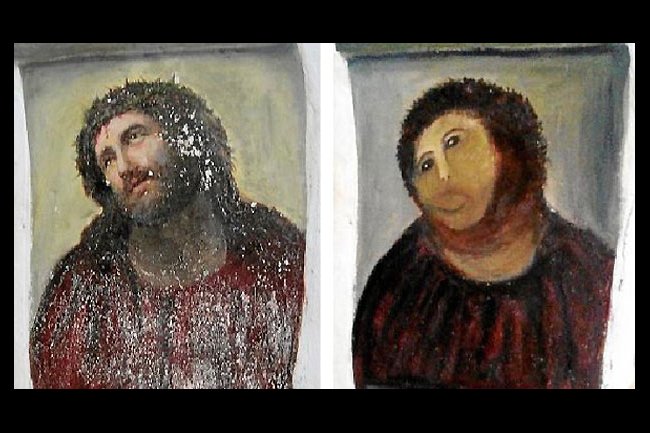Never Try to Restore any Antiquities or Collectibles without Expert Advice

Remember that famous botched "restoration" job of the Spanish fresco painting of Jesus Christ by an 80 year old woman? If not, ten years ago, the artist, Cecilia Jimenez, volunteered to restore the painting. Her "restoration" was so poorly done, the term "ecce monkey" was sometimes used to describe the artwork. (The original name was Ecce Homo)
She felt bad about her "creation" given the negative reception it received around the world.
Well, it turned out the church, who owns the painting, received so much attention and was so popular with tourists, that it charged an admission fee. So ironic that the lady, who originally felt bad about the original misfortune, wanted a cut of the admission fees the church collected. In 2016, some of the funds from tourist receipts allowed an interpretation center to be opened in the town of Borja, Spain.
Unfortunately, very few amateur attempts at restoration, fixing, cleaning or altering art, antiques and collectibles receives positive results. The vast majority of novices cleaning coins, mending paper or even applying ink or paint turns disastrous.
As any expert will tell you, it's better to leave the artifact alone then attempt to repair its problems on your own. A novice trying to fix a problem can really do more damage.
Old and rare coins, for example, have been damaged and have suffered major devaluation by people unaware of the harm amateur cleaning causes. Some have even attempted to clean their coins to the point some of the original surface is removed or deep scratches appear. It has been done. Whether soaking a coin in cola, using a toothbrush. Even something more mild like baking soda. All forms of cleaning products can product a negative effect on the coin.
These impairments end up damaging the coin, thereby decreasing its value and the chance of selling it. When the coin is submitted for condition and authentication opinion to a recognized organization like PCGS or NGC, the coin is encased in a holder with the defects noted on the holder.
With paper items like historical documents, antique maps, rare prints and other paper antiquities, many people, not aware of the harm, will apply adhesive tape to close a tear or "fix" missing portions of paper. After several years of adhesion to the paper, the tape acids will eventually discolor and brown the area where the tape was stuck to the paper. Again, this lessens the value and greatly affects the appearance.
Also, never use an eraser to remove any stray marks or writing. People unaware of the problems will use a common eraser from a #2 pencil. This bleeds the affected marks and worsens the appearance.
Any restoration attempts should ALWAYS be left to the experts, like museum curators and conservators. Qualified conservators have many years of on hands experience and knowledge they have acquired through training, study and taking tests. Because of their training, they are very experienced in knowing the right chemicals and/or restoration methods to clean and repair the area without harm.
Trained restorers can be found through research on the internet, word of mouth and seeking advice from a knowledgeable expert in a related field. Just don't take it on yourself to do the work of an expert. Seek proper advice from a true expert and save yourself the headaches and expense you may create.
